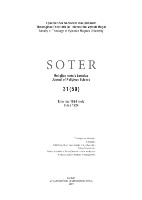Kauno seserų benediktinių vienuolyno pertvarka 1918–1926 m. (II)
THE REFORM IN THE CONVENT OF THE BENEDICTINE SISTERS OF KAUNAS FROM 1918 TO 1926 (II)
Author(s): Artūras Grickevičius, Aušra Vasiliauskaitė (Sr. Gabrielė OSB)Subject(s): Christian Theology and Religion
Published by: Vytauto Didžiojo Universitetas
Keywords: seserys benediktinės; vienuolynai; pertvarka; regula; kanonų teisė; Benedictine sisters; convents; reform; Rule; Canon Law
Summary/Abstract: The Act of Independence of Lithuania signed in 1918 brought an air of confusion to the Convent of the Benedictine Sisters of Kaunas, which had just recovered after the czarist persecution. The Sisters of Polish descent that made up the majority in the community had no concern to turn the convent into the hearth of Lithuanian culture. In 1919, due to the escalation of national relations, the convent was visited by bishop Karevičius. His visit marked the initial stage of the convent’s political-material reform. The discontent Polish sisters complained to the Holy See and in 1920 the convent was already under irrevocable papal jurisdiction. Therefore, the community of diocesan rights became that of papal rights with a corresponding closure. Under the visitator A. Ratti, when the Polish nuns opposed the establishment of a Lithuanian school at the convent, the conflict came to a sharper point. Later, under the visitator A. Zecchini, the issue concerning Lithuania, attracted the attention of some other European countries, as well. Consequently, it was decided to eject the Polish nuns who settled in Kolainiai in 1924. Then papal delegate archbishop Jurgis Matulatis commences the second, i.e. monastic-spiritual stage of the reform. In Vatican the convent was entitled as congregation, whereas in Lithuanian records it existed as convent. Te change of the title does not, however, result in the change of jurisdiction. The Congregation of St Scholastica (USA), the Constitution of which was adopted by the Benedictine Sisters of Kaunas, is that of papal rights. The responses of the present day Benedictine Sisters of Kaunas to the questionnaire reveal that the reform of Jurgis Matulaitis resulted in the annulment of the papal closure and the reestablishment of the diocesan rights. Thus, the convent became a congregation, Yet, it must be observed, that the above mentioned fact is not in accordance with the Benedictine tradition. Taking into account the principles listed in the Rule of St. Benedict, the reform had apparently more negative outcomes than positive ones. It impoverished liturgy which functioned as the centre of monastic life; the abridged prayers destroyed the harmonious relation between work and prayer proposed by the Rule. Such conditions served well for the loss of Benedictine identity of the community rather than for the revival of it. From the point of view of the Canon Law, it can be presumed that the reform was carried out in accordance with the requirements, yet regardless of the situation of the convent. It was difficult for the sisters to deliver the requirements of the papal closure, the issue of the monastic vows was complicated and the problem of the title of the congregation was not solved. Moreover, despite canonical correctness, the problem of jurisdiction was not entirely solved. From historical point of view, it may be stated that Jurgis Matulaitis did not start the reform and did not annul the papal closure. Accordingly, despite th
Journal: SOTER: religijos mokslo žurnalas
- Issue Year: 59/2009
- Issue No: 31
- Page Range: 111-124
- Page Count: 14
- Language: Lithuanian

